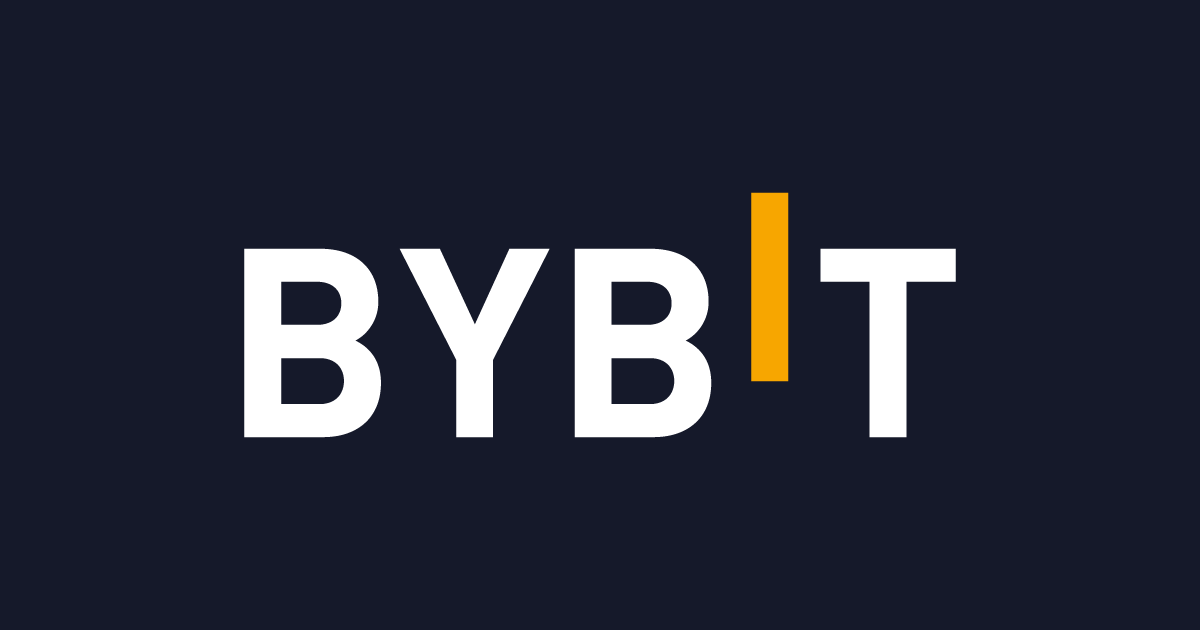Looking for the right crypto exchange can be overwhelming with so many options available. Bybit and Poloniex are two popular platforms that offer cryptocurrency trading services, but they differ in several key aspects that might affect your trading experience.
When choosing between Bybit and Poloniex in 2025, you should consider their fee structures, available cryptocurrencies, trading types, and user interface to find which better suits your needs. Both exchanges offer competitive features, but they cater to slightly different user preferences and trading styles.
Understanding these differences can help you make an informed decision about where to invest your money. Each platform has its strengths – from Bybit’s focus on derivatives trading to Poloniex’s longer history in the crypto space. Let’s explore how these exchanges compare across important factors that matter to crypto traders.
Bybit vs Poloniex: At A Glance Comparison
Bybit and Poloniex are both popular cryptocurrency exchanges that offer trading services to users worldwide. Let’s compare their key features to help you decide which platform might work better for your needs.
Trading Volume Ranking:
- Poloniex: Around 15th largest exchange
- Bybit: Generally ranks higher in global volume
Key Features Comparison:
| Feature | Bybit | Poloniex |
|---|---|---|
| Founded | 2018 | 2014 |
| Trading Types | Spot, Futures, Options | Spot, Margin |
| User Interface | Modern, intuitive | Functional, slightly dated |
| Mobile App | Comprehensive | Basic functionality |
| Security | Strong security measures | Decent security history with some past issues |
- Fee Structure: Both exchanges offer competitive fee structures, but they differ in specifics. Bybit typically offers slightly better rates for high-volume traders while Poloniex has a more standardized approach.
- Cryptocurrency Selection: Poloniex offers a wide range of altcoins, making it good for traders looking for variety. Bybit focuses more on popular cryptocurrencies with deeper liquidity.
- Regulatory Compliance: You should note that both exchanges have different regulatory standings depending on your country. Always check if they’re available in your region.
- User Experience: Bybit tends to appeal to more advanced traders with its robust features. Poloniex offers a simpler approach that might be less overwhelming for newer traders.
Bybit vs Poloniex: Trading Markets, Products & Leverage Offered
Bybit and Poloniex both offer a range of trading options, but they differ in their offerings and specialties.
Bybit is known for its strong focus on leverage trading. You can access up to 100x leverage on certain cryptocurrency pairs, making it popular with traders looking for amplified exposure. Bybit supports spot trading, futures, and options.
Poloniex offers trading for over 350 cryptocurrencies, giving you access to a wider variety of altcoins. Their leverage options are more limited compared to Bybit, but they provide a robust spot trading experience.
| Feature | Bybit | Poloniex |
|---|---|---|
| Cryptocurrencies | 150+ | 350+ |
| Maximum Leverage | Up to 100x | Lower than Bybit |
| Spot Trading | Yes | Yes |
| Futures | Yes | Limited |
| Options | Yes | No |
| Copy Trading | Yes | No |
Bybit has deeper liquidity in leveraged trading markets, which can result in better execution prices when you’re trading popular pairs. Their platform is designed with advanced traders in mind.
Poloniex shines in the diversity of assets available for trading. If you’re interested in exploring newer or less mainstream cryptocurrencies, Poloniex might be the better choice.
Also Read: Are Crypto Options Legal in the US?
Both exchanges offer mobile apps and desktop platforms, allowing you to trade from different devices. Bybit’s interface tends to be more sophisticated, while Poloniex offers a straightforward trading experience.
Bybit vs Poloniex: Supported Cryptocurrencies
When choosing a crypto exchange, the variety of available cryptocurrencies is a key factor to consider. Both Bybit and Poloniex offer a range of digital assets, but there are notable differences between them.
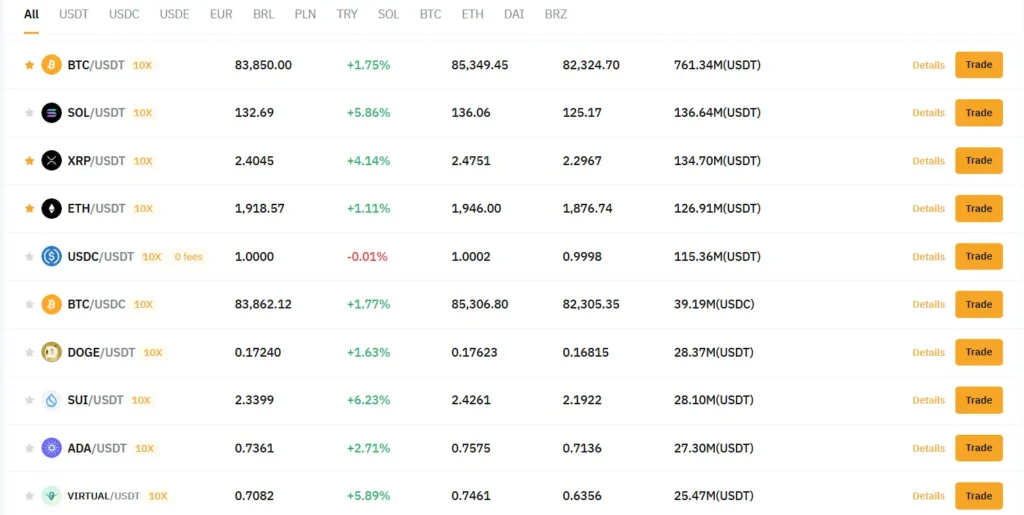
Bybit supports a larger selection of cryptocurrencies compared to Poloniex. As of March 2025, Bybit has expanded its offerings to include more altcoins and emerging tokens alongside the major cryptocurrencies.
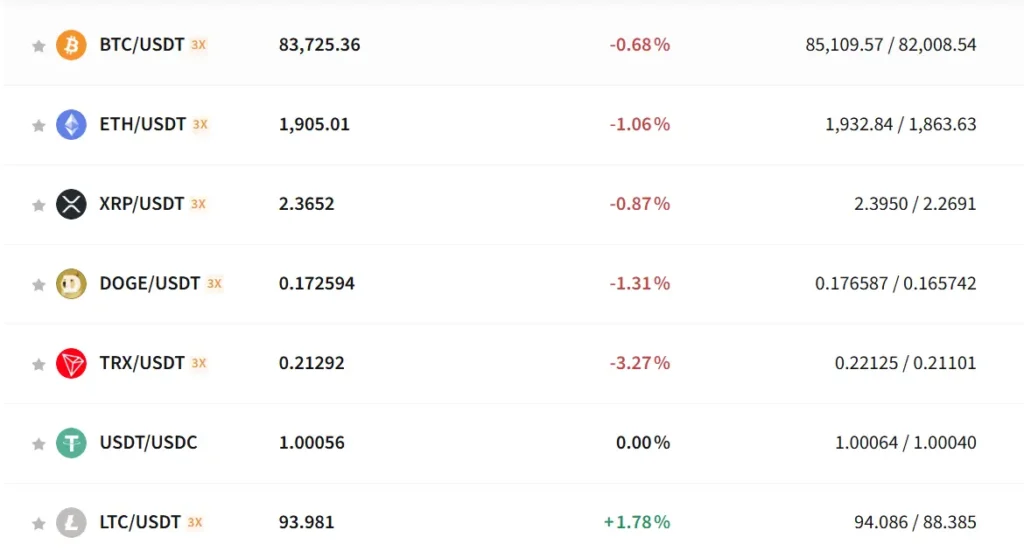
Poloniex, while having fewer total cryptocurrencies, still provides access to many popular coins and has historically been known for listing some altcoins before they appear on other exchanges.
Here’s a quick comparison of their cryptocurrency support:
| Feature | Bybit | Poloniex |
|---|---|---|
| Total cryptocurrencies | Higher number | Lower number |
| Major coins (BTC, ETH, etc.) | ✅ | ✅ |
| Altcoin variety | Extensive | Good but more limited |
| New token listings | Regular additions | Selective additions |
Both exchanges support the most popular cryptocurrencies like Bitcoin, Ethereum, and other top market cap coins. You’ll find the major stablecoins on both platforms as well.
If you’re looking to trade a wide variety of altcoins or newer tokens, Bybit might be the better choice due to its more extensive selection. However, if your trading focuses mainly on established cryptocurrencies, either exchange would meet your needs.
Bybit vs Poloniex: Trading Fee & Deposit/Withdrawal Fee Compared
Trading fees are a key factor when choosing between Bybit and Poloniex. Both exchanges have different fee structures that can impact your trading costs.
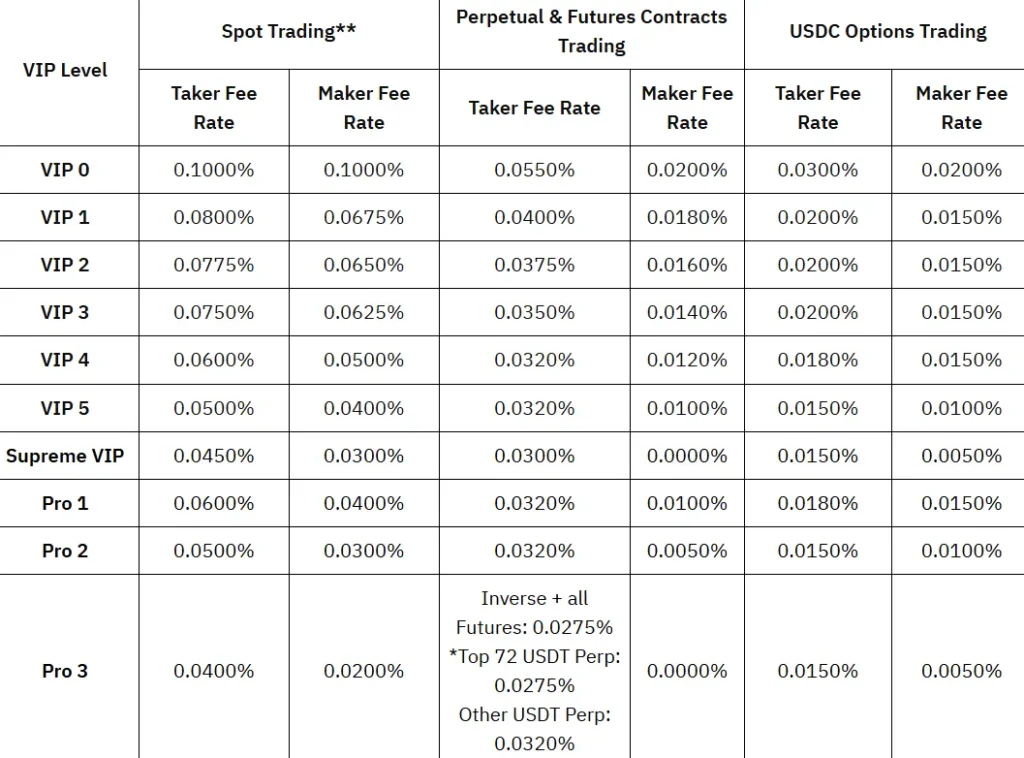
Bybit offers a maker-taker fee model with competitive rates. Makers typically pay 0.01% to 0.1% while takers pay between 0.025% to 0.1% depending on your trading volume.
Poloniex also uses a maker-taker model, with fees ranging from 0% to 0.1% for makers and 0.1% to 0.2% for takers. Your fee rate decreases as your 30-day trading volume increases.
Deposit Fees:
- Bybit: Generally free for crypto deposits
- Poloniex: No fees for most crypto deposits
Withdrawal Fees:
| Exchange | Withdrawal Fees |
|---|---|
| Bybit | Varies by cryptocurrency (e.g., 0.0005 BTC, 0.005 ETH) |
| Poloniex | Varies by cryptocurrency (e.g., 0.0004 BTC, 0.01 ETH) |
You can reduce trading fees on both platforms. Bybit offers fee discounts for holding their native tokens or maintaining high trading volumes. Poloniex provides similar volume-based discounts.
It’s important to check the current fee schedules on both exchanges’ websites as they may change periodically. The specific withdrawal fees also differ for each cryptocurrency you want to withdraw.
Consider your trading style and frequency when comparing these fees. High-volume traders might benefit more from one platform’s fee structure than occasional traders.
Bybit vs Poloniex: Order Types
When trading crypto, the types of orders available can make a big difference in your strategy. Both Bybit and Poloniex offer various order types, but they differ in some important ways.
Bybit provides a comprehensive range of order options. You can use basic orders like Market, Limit, and Stop orders for straightforward trading. For more advanced strategies, Bybit offers Conditional orders, Take Profit and Stop Loss orders, and Trailing Stop orders.
Poloniex supports the essential order types including Market, Limit, and Stop-Limit orders. However, it has fewer advanced order options compared to Bybit.
Here’s a quick comparison of order types available on both platforms:
| Order Type | Bybit | Poloniex |
|---|---|---|
| Market | ✅ | ✅ |
| Limit | ✅ | ✅ |
| Stop | ✅ | ❌ |
| Stop-Limit | ✅ | ✅ |
| Take Profit | ✅ | ❌ |
| Stop Loss | ✅ | ❌ |
| Trailing Stop | ✅ | ❌ |
| Conditional | ✅ | ❌ |
Bybit’s wider variety of order types gives you more flexibility to customize your trading strategy. This can be particularly useful if you engage in active trading or need precise entry and exit points.
For beginners, Bybit’s range might seem overwhelming at first. Poloniex’s simpler selection could be easier to navigate initially, but might feel limiting as you develop more advanced trading techniques.
Bybit vs Poloniex: KYC Requirements & KYC Limits
Bybit and Poloniex have different approaches to KYC (Know Your Customer) verification that affect how you can use their platforms.
Bybit uses KYC to identify customers and assess risk profiles. This verification helps prevent money laundering and other illegal activities. Bybit offers different verification levels, with each level providing increased account benefits and features.
Poloniex makes KYC optional for accounts with smaller trading volumes. However, if you want increased limits and access to more features, you’ll need to complete verification on Poloniex.
Bybit KYC Benefits:
- Enhanced account security
- Higher withdrawal limits
- Access to more trading features
- Compliance with regulations
Poloniex KYC Approach:
- Optional verification for basic accounts
- Increased limits for verified users
- Most funds stored offline for security
- Tiered verification system
Without KYC verification, you can still use basic features on both platforms, but with significant limitations. Poloniex is often considered more friendly to users seeking minimal verification requirements.
For serious traders who need higher transaction limits, completing KYC on either platform is recommended. This ensures you can access all available features and higher withdrawal limits.
The verification process on both exchanges typically requires submitting government ID and proof of address documents.
Bybit vs Poloniex: Deposits & Withdrawal Options
When choosing between Bybit and Poloniex, understanding the deposit and withdrawal options is crucial for your trading experience.
Bybit supports multiple deposit methods including bank transfers, credit/debit cards, and cryptocurrency deposits. You can fund your account with major cryptocurrencies like Bitcoin, Ethereum, and various stablecoins.
Poloniex primarily focuses on crypto-to-crypto transactions. This means you’ll need to already own cryptocurrency to deposit into your Poloniex account.
Both exchanges offer cryptocurrency withdrawals, but they differ in processing times and fees.
| Feature | Bybit | Poloniex |
|---|---|---|
| Fiat Deposits | ✅ (Bank transfer, cards) | ❌ |
| Crypto Deposits | ✅ | ✅ |
| Withdrawal Methods | Crypto, some fiat options | Crypto only |
| Withdrawal Processing | Generally faster | Can be slower |
Bybit typically processes withdrawals faster than Poloniex, which might be important if you need quick access to your funds.
Fee structures vary between the platforms. Bybit charges network fees for crypto withdrawals that change based on blockchain congestion. Poloniex has fixed withdrawal fees for each cryptocurrency.
Minimum deposit and withdrawal amounts also differ between the exchanges. You should check their current limits before choosing which platform suits your needs better.
Remember that withdrawal limits may increase with higher verification levels on both platforms, so completing identity verification can improve your withdrawal options.
Bybit vs Poloniex: Trading & Platform Experience Comparison
Bybit offers a more intuitive user interface designed with beginners and experienced traders in mind. The platform features a clean dashboard where you can easily access different trading options.
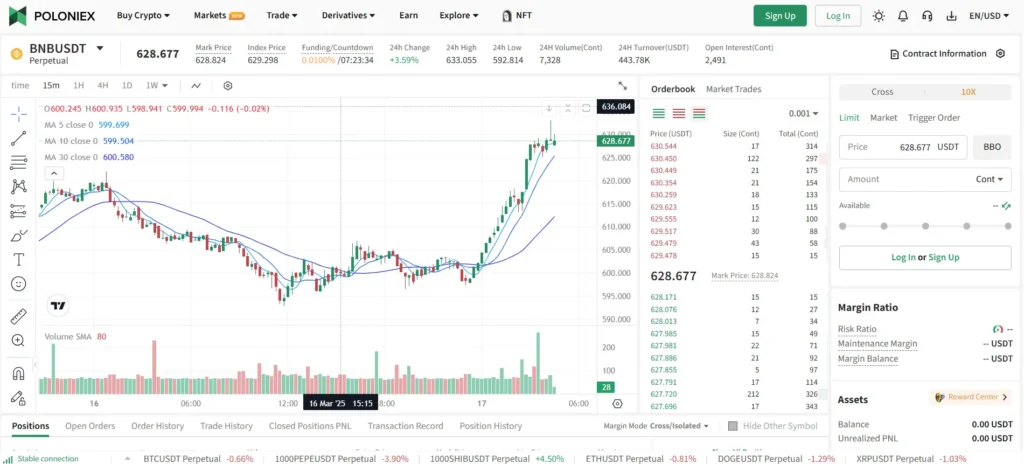
Poloniex provides access to a wider range of cryptocurrency assets compared to Bybit. This gives you more options for diversifying your crypto portfolio.
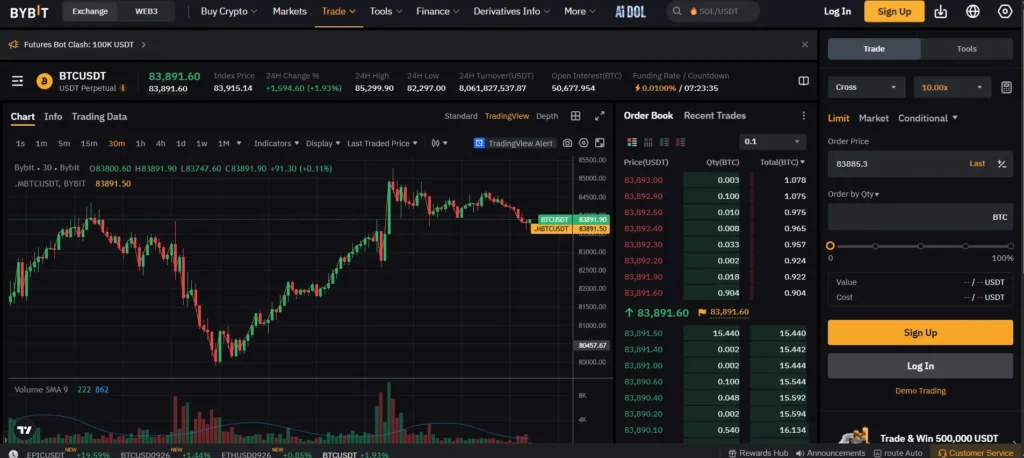
When it comes to trading tools, Bybit stands out with advanced charting capabilities and technical analysis features. You’ll find more sophisticated order types like limit, market, and conditional orders.
User Experience Comparison:
| Feature | Bybit | Poloniex |
|---|---|---|
| Interface | Sleek, modern design | Functional but less intuitive |
| Mobile App | Highly rated, full-featured | Basic functionality |
| Loading Speed | Fast | Sometimes slower during high volume |
Poloniex’s platform might feel slightly outdated but remains functional for most trading needs. The exchange has been around longer, which explains its classic interface design.
Both platforms offer mobile apps, but Bybit’s app receives higher user ratings for its comprehensive features and reliability. You can perform nearly all desktop functions on Bybit’s mobile app.
Trading fees are competitive on both platforms, though they vary based on your trading volume and account tier. Bybit typically offers more promotional fee discounts for new users.
Customer support is an area where Bybit generally performs better, with faster response times and more support channels available to you when issues arise.
Bybit vs Poloniex: Liquidation Mechanism
When trading with leverage on crypto exchanges, understanding the liquidation mechanism is crucial for managing risk. Both Bybit and Poloniex have systems in place to protect themselves when your positions approach dangerous loss levels.
Bybit uses a tiered liquidation mechanism. First, it sends warnings when your position approaches the liquidation price. If your margin ratio falls below the maintenance margin requirement (usually 0.5%), Bybit’s system gradually liquidates your position.
Poloniex, on the other hand, employs a more straightforward approach. When your position reaches the liquidation threshold, the entire position may be closed at once without the graduated system that Bybit offers.
Key Differences:
| Feature | Bybit | Poloniex |
|---|---|---|
| Warning System | Multiple alerts | Limited warnings |
| Liquidation Type | Partial/Tiered | Full position |
| Insurance Fund | Well-funded | Smaller fund |
| Liquidation Price Calculator | Advanced tools | Basic calculator |
Bybit’s insurance fund is generally larger, which can help prevent auto-deleveraging (ADL) where profitable traders share liquidation losses. This makes Bybit potentially safer during market volatility.
You’ll find more control tools on Bybit, including adjustable leverage and take-profit/stop-loss options that can help you avoid liquidation entirely.
For new traders, Bybit’s gradual liquidation process may be more forgiving when you’re learning how leveraged trading works. The platform gives you more time to react and possibly save your position.
Bybit vs Poloniex: Insurance
When choosing a crypto exchange, security measures like insurance are crucial for protecting your assets. Both Bybit and Poloniex offer some form of insurance protection, but they differ in approach.
Bybit maintains an insurance fund to protect users against auto-deleveraging during volatile market conditions. This fund has grown significantly over time and helps manage risk for traders using leverage.
Poloniex also provides an insurance mechanism, but it’s typically smaller in scope compared to Bybit. Their focus tends to be more on security protocols rather than maintaining a large insurance fund.
Neither platform offers full insurance coverage for all user assets. Most protection is limited to specific circumstances like system failures or security breaches.
Insurance Comparison:
| Feature | Bybit | Poloniex |
|---|---|---|
| Insurance Fund | Larger fund size | Smaller fund size |
| Coverage Focus | Trading losses from auto-deleveraging | Basic security breaches |
| User Protection | Stronger for futures trading | Limited to specific scenarios |
You should note that neither exchange offers FDIC-type insurance that traditional banks provide. Your crypto remains subject to market risks and potential security issues.
For maximum protection, consider using hardware wallets for long-term storage regardless of which platform you choose for trading.
Bybit vs Poloniex: Customer Support
When choosing a crypto exchange, good customer support can make a big difference in your trading experience. Both Bybit and Poloniex offer support options, but with some notable differences.
Bybit provides 24/7 customer support, as mentioned in the search results. This means you can get help at any time, regardless of your time zone. Their support team is available through live chat, email, and an extensive help center.
Poloniex also offers 24/7 customer support according to the search results. Their support channels include ticket submission, email support, and a knowledge base with frequently asked questions.
Response Time Comparison:
| Exchange | Average Response Time | Support Channels |
|---|---|---|
| Bybit | Usually within minutes (live chat) | Live chat, email, help center |
| Poloniex | Usually within 24 hours | Ticket system, email, knowledge base |
Both platforms offer English language support, with Bybit providing support in multiple languages for international users.
User feedback suggests that Bybit’s live chat feature gives it an edge for immediate assistance. However, Poloniex has improved its support services in recent years.
When you encounter issues, remember to check each platform’s help center first. Many common questions are already answered there, saving you time waiting for support responses.
Bybit vs Poloniex: Security Features
When choosing between Bybit and Poloniex, security should be a top priority for your crypto assets. Both exchanges offer several security measures to protect users.
Bybit implements multi-signature cold wallets to store most user funds offline. This approach significantly reduces the risk of hacking attempts. They also use two-factor authentication (2FA) to secure your account.
Poloniex also utilizes cold storage technology for most customer funds. Their security team monitors the platform 24/7 for suspicious activities. Like Bybit, they require 2FA for all withdrawals.
Key Security Features Comparison:
| Feature | Bybit | Poloniex |
|---|---|---|
| Cold Storage | Yes | Yes |
| Two-Factor Authentication | Yes | Yes |
| Anti-Phishing Code | Yes | No |
| Advanced Encryption | Yes | Yes |
| Insurance Fund | Yes | Limited |
Bybit offers an anti-phishing code feature that helps you verify emails are legitimate. This gives Bybit a slight edge in phishing protection.
Both platforms require identity verification to comply with KYC regulations. This helps prevent fraud and money laundering activities.
Poloniex has experienced a security breach in the past, losing about 12% of its assets in 2014. Since then, they’ve strengthened their security protocols considerably.
Bybit hasn’t reported any major security incidents so far, which might give you more confidence in their security infrastructure.
Is Bybit a Safe & Legal To Use?
Bybit has faced some security challenges recently. A forensic review revealed that a $1.5 billion hack was not due to vulnerabilities in Bybit’s platform, but rather stemmed from issues with Safe Custody.
Keeping crypto on any exchange, including Bybit, comes with risks. Exchanges can freeze withdrawals or face security issues, as shown by recent events.
Legal status in the USA:
Bybit is not legal to use in the United States. The US has strict cryptocurrency trading regulations, and Bybit operates as an unregulated crypto exchange in the country.
Comparison with Poloniex:
Bybit offers more cryptocurrencies than Poloniex, which might be appealing if you’re looking for variety in your trading options.
Safety recommendations:
If you choose to use Bybit (in regions where it’s legal), consider these safety measures:
- Enable two-factor authentication
- Use strong, unique passwords
- Never store large amounts on the exchange
- Consider transferring to a hardware wallet for long-term storage
Always verify the current legal status of cryptocurrency exchanges in your country before using them. Regulations change frequently in the crypto space.
Is Poloniex a Safe & Legal To Use?
Poloniex is a cryptocurrency exchange that has been operating since 2014. This lengthy presence in the market shows some stability in a volatile industry.
When considering safety, Poloniex has experienced security issues in the past. According to search results, the platform did suffer a security breach previously, which raises some concerns.
Despite this history, some sources consider Poloniex to be among the more secure cryptocurrency exchanges available today.
Important safety considerations:
- Poloniex lacks regulation from strict financial authorities
- Some sources explicitly state it is “not a trusted broker” due to this lack of regulation
- The platform has been operating for nearly a decade
The legal status of Poloniex varies by location. You should check if cryptocurrency trading through Poloniex is permitted in your country before using the platform.
When comparing safety features with other exchanges like Bittrex, sources suggest both platforms offer security measures to protect users.
Security measures to note:
- Two-factor authentication
- Cold storage for most funds
- Email confirmations for withdrawals
You should always use strong passwords and enable all available security features when using any cryptocurrency exchange, including Poloniex.
Also Read: Crypto Options Arbitrage: How to Profit from Mispricing
Remember that cryptocurrency trading involves risks regardless of the platform you choose. Never invest more than you can afford to lose.
Frequently Asked Questions
Traders often have specific questions when comparing cryptocurrency exchanges like Bybit and Poloniex. These platforms differ in several key aspects that might influence your trading decisions.
What are the differences in fees between Bybit and Poloniex for trades and withdrawals?
Bybit generally offers a more competitive fee structure with maker fees starting at 0.1% and taker fees at 0.1%. Their fee schedule uses a tiered system based on your trading volume.
Poloniex has slightly higher fees in comparison, with standard trading fees starting at 0.15% for makers and 0.25% for takers. Both exchanges offer fee discounts for high-volume traders.
Withdrawal fees vary by cryptocurrency on both platforms. Bybit typically charges network fees, while Poloniex may have fixed withdrawal fees for certain assets.
How do the security measures offered by Bybit compare with those implemented by Poloniex?
Bybit implements robust security with mandatory two-factor authentication (2FA), cold storage for most funds, and regular security audits. They also maintain an insurance fund to protect users against losses.
Poloniex offers similar security features including 2FA, cold storage solutions, and anti-phishing measures. However, Poloniex has experienced security incidents in the past, including a hack in 2014.
Both platforms require identity verification through KYC procedures, though Bybit’s security infrastructure is generally considered more modern and comprehensive.
Can users from the United States trade on Bybit or Poloniex, and what are the restrictions?
Neither Bybit nor Poloniex currently accepts traders from the United States due to regulatory constraints. Bybit stopped serving US customers in 2021 following regulatory pressures.
Poloniex exited the US market in 2019 and transferred US accounts to Circle. Both exchanges enforce these restrictions through IP detection and verification processes.
US traders need to use VPN services at their own risk or choose alternative exchanges that comply with US regulations.
Which platform, Bybit or Poloniex, offers a wider range of cryptocurrencies for trading?
Poloniex offers a wider selection of cryptocurrencies with support for over 100 different digital assets and 300+ trading pairs. They’re known for listing many altcoins and smaller cap tokens.
Bybit focuses more on popular cryptocurrencies with around 50+ coins available for trading. Their selection includes major cryptocurrencies and some trending altcoins.
If you’re looking to trade niche or emerging cryptocurrencies, Poloniex typically provides more options than Bybit.
How do the user interface and trading experience of Bybit differ from those of Poloniex?
Bybit offers a more intuitive and modern interface with a cleaner design that’s easier for beginners to navigate. Their mobile app receives higher ratings for usability and features.
Poloniex has a more traditional exchange interface that experienced traders might prefer. It provides detailed market information but can feel cluttered and overwhelming to new users.
Bybit’s platform includes more educational resources and guides, while Poloniex focuses on providing comprehensive trading tools and data.
What are the margin trading options available on Bybit versus those on Poloniex, and what leverage ratios do they offer?
Bybit specializes in derivatives trading with leverage up to 100x on certain futures contracts. Their platform offers USDT perpetuals, inverse perpetuals, and options trading.
Poloniex offers margin trading with more modest leverage options, typically up to 5x for eligible cryptocurrencies. Their margin trading is available for a limited selection of trading pairs.
Bybit provides more advanced features for leveraged trading, including take-profit and stop-loss orders, while Poloniex offers a simpler margin trading experience with fewer advanced tools.
Poloniex vs Bybit Conclusion: Why Not Use Both?
After comparing Bybit and Poloniex, it’s clear that each exchange offers unique benefits. Bybit scores higher overall with a 7.9 rating compared to Poloniex, according to recent 2025 data.
Bybit provides a smoother user experience with a simpler interface, making it great for beginners. It also has strong security measures, though the recent controversy with Safe Custody regarding a $1.5B hack raises some questions.
Poloniex shines with its wider range of cryptocurrency assets. If you’re looking to trade more obscure altcoins, this platform might be your better option.
When it comes to features, here’s a quick comparison:
| Feature | Bybit | Poloniex |
|---|---|---|
| User Experience | Smoother, simpler | More complex |
| Crypto Selection | Good | Excellent |
| Security | Strong (despite recent issues) | Good |
| Best For | Beginners to intermediate | Altcoin traders |
There’s no rule saying you must choose just one exchange. Many traders use multiple platforms to take advantage of different features, trading pairs, and fee structures.
You might use Bybit for its user-friendly interface when making common trades, while keeping Poloniex for access to a wider variety of cryptocurrencies.
By using both exchanges, you can benefit from the strengths of each platform while minimizing their individual weaknesses.
Compare Bybit vs Poloniex with other significant exchanges

